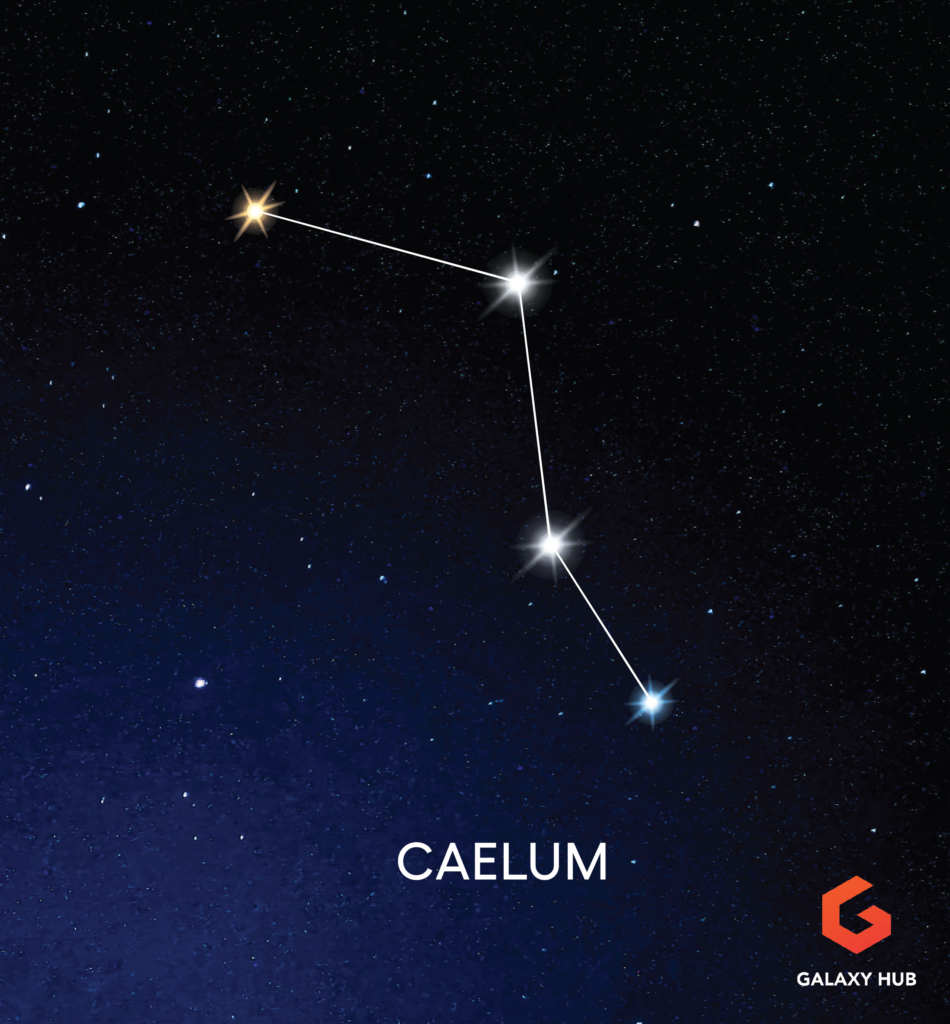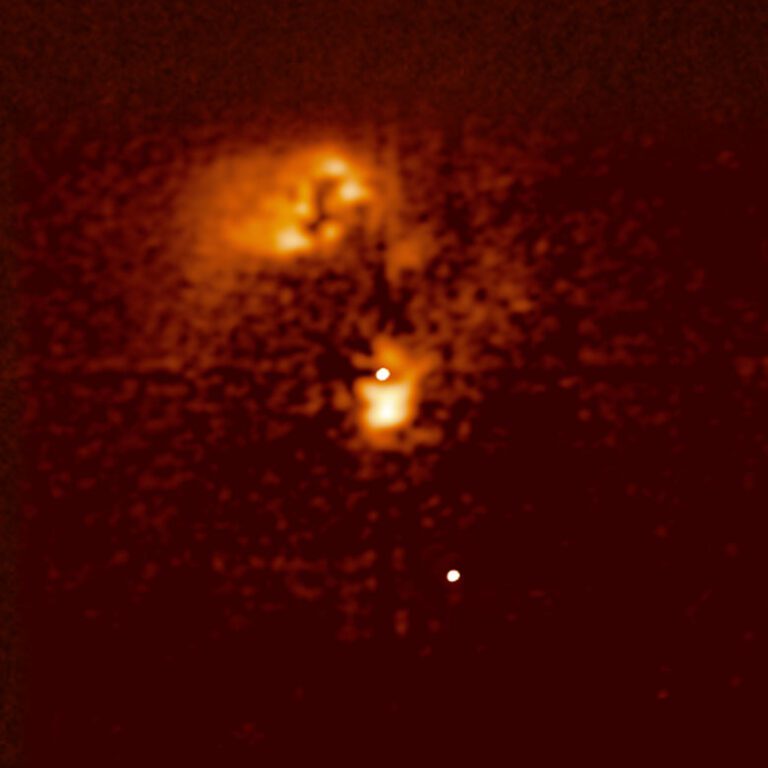
Caelum is a small, faint constellation visible in the southern sky.
One of the 88 modern constellations, Caelum is the 8th smallest in the sky with only four main stars. Its two brightest are barely brighter than magnitude 5, so you will have to seek out dark skies with minimal light pollution to view Caelum. Caelum is difficult to find because of how faint and small it is, so it can be a fun challenge for stargazers!
The best time of year to view caelum is January, and anyone from the south pole to a latitude of 40 degrees can spot it in the sky. A common translation of the word caelum in Latin means “sky or heaven,” but this constellation uses a rarer translation of the word.
Formerly known as Caelum Sculptoris, or the engraver’s chisel, Caelum simply means chisel. The constellation contains no Messier objects, but it does contain several interesting deep sky objects.
Caelum Key Data
Name
| Latin | English | Pronunciation | Genitive | Abbreviation |
| Caelum | Chisel | See-lum in English; kai-lum in Latin | Caeli | Cae |
Location
| Hemisphere | Best Seen | R.A. | Declination |
| Southern | November to January | 5h 00m 00s | -27.02° to -48.74° |
Features
| Area | Size Rank | # of Messier Objects | # of Stars Brighter than Mag 4 | Brightest Star |
| 125 sq. Deg. | 81st | 0 | 0 | Alpha Caeli, Mag 4.44 |
Top Caelum Facts
- Caelum is the 8th smallest constellation in the sky
- Caelum lies far away from the plane of the Milky Way, which is why it is so faint
- Caelum is best observed in the winter, from November to January
- The Lambda Caelid meteor shower originates in Caelum
- Caelum contains the eclipsing binary star RR Caeli, which is orbited by an exoplanet four times the mass of Jupiter
- This constellation was not recognized by any ancient civilizations
Caelum in Mythology
Because Caelum is a small group of four faint stars, it was not a constellation that ancient civilizations typically identified. In fact, no one formed a constellation from this group of stars until the 18th century!
Though Caelum has no mythological past, it does have a history which is detailed below.
Caelum in History
Caelum is not one of the original constellations as outlined by Ptolemy.
Instead, it is one of fourteen constellations created in the 1750s by French astronomer Nicolas Louis de Lacaille.
While Lacaille gave the constellation a Latin name, Caelum Sculptoris, the latter part of the name was eventually dropped by English astronomer Francis Bailey. Thus, the constellation went from being “the engraver’s chisel” to simply “the chisel.”
When Lacaille originally drew the constellation, it showed a pair of engraving tools, but it was later simplified to one. The French still refer to it by the name Burin, which means chisel in French.
When and How to See Caelum
Observers in any part of the southern hemisphere can see Caelum easily, but only observers below the 40° latitude line in the northern hemisphere can view it – for more northern latitudes, it’s below the horizon.
Caelum is surrounded by a number of other constellations and lies east of Columba and west of Eridanus and Horologium. It is north of Dorado and Pictor and south of Lepus.
One way to find Caelum is to locate the bright star Canopus in the constellation Carina. Then, move east until you see the lines of four faint stars that makes up Caelum.

Caelum’s Notable Stars
| Bayer/Gould Designation | Name (s) | Mag | R.A. | Dec. | Distance (LY) | Notes |
| Alpha / 9 | Alpha Caeli | 4.44 | 04h 40m 34s | -41° 51’ 49” | 66 | Caelum’s brightest star and a binary system |
| Beta / 10 | Beta Caeli | 5.04 | 04h 42m 03s | -37° 08’ 42” | 90 | A suspected single-lined spectroscopic binary system |
| Gamma / 28 | Gamma1 Caeli | 4.55 | 05h 04m 24s | -35° 28’ 58” | 185 | A double star system. γ1 Cae A is the constellations’s second brightest star |
| Delta / 7 | Delta Cae | 5.07 | 04h 30m 50s | -44° 57’ 13.5” | 710 | Probable variable star |
Alpha Caeli
Alpha Caeli is Caelum’s brightest star. Caelum’s shape is basically a slightly zig-zagged line, and Alpha Caeli is the second star from the bottom of the line.
Alpha Caeli is technically a binary star system. The primary star is Caelum’s brightest star, coming in at a mass of 1.48 solar masses. It is also thought to be a Delta Scuti variable star. The companion star is a red dwarf with a magnitude of 9.80, so only the primary is visible to the naked eye.
One interesting fact to note about Alpha Caeli is that astronomers believe it is a member of the Ursa Major moving group – a group of stars that possess similar characteristics of motion, and thus are thought to have originated in the same star cluster.
Beta Caeli
Beta Caeli is the second star from the top of the constellations. It’s dim but still visible to the naked eye. It is similar in size to the sun, with a mass and radius of approximately 1.3 times the mass and radius of the sun.
It is thought to be a spectroscopic binary star. Beta Caeli primary’s suspected companion has a very low mass, just 0.2 times the mass of the sun, and is thought to be orbiting at a radius of 5 AU. Astronomers think that its mysterious, probable companion could be the potential source of X-ray emission that is coming from that location in space.
Gamma1 Caeli
Gamma1 Caeli is the top star in the constellation, located above Beta Caeli in the sky. It is a double star system comprised of a K-type giant star and a G-type subgiant star.
Gamma1 Caeli A is dim but visible to the naked eye. It has a similar mass to the sun, but its photosphere is swollen and the star’s width has ballooned to 14.3 times that of the sun’s.
Gamma1 Caeli B has a mgnitude of 8.07, so it is only visible through binoculars. It is similar in size to the sun, bu poorer in metal abundance.
Delta Caeli
Delta Caeli is a blue-white star at the tail end of the chisel, underneath Alpha Caeli. Compared to the other stars in the constellation, it’s located much further away from Earth. This means that its magnitude is diminished by interstellar dust between the star and Earth. In spite of this, it is still barely visible with the naked eye.
This is because of Delta Caeli’s size: the star is over 7 times the sun’s mass, about 4 times the sun’s radius, and it radiates over 2,500 times the sun’s luminosity.
Caelum’s Deep Sky Objects
| Object | Name(s) | Type | Mag | R.A. | Dec. | Distance (LY) | Min. Equipment |
| PGC 15172 | Carafe Galaxy | Spiral Galaxy | 12 | 04h 28m 00s | -47° 54’ 46” | 230 million | Medium Telescope |
| NGC 1595 | N/A, part of Carafe Group | Elliptical Galaxy | 12.7 | 04h 28m 22s | -47° 48’ 57” | 225 million | Medium Telescope |
| NGC 1598 | N/A, part of Carafe Group | Spiral Galaxy | 13.3 | 04h 28m 34s | -47° 46’ 57” | 240 million | Medium Telescope |
| PN G243.8-37.1, or PN PRTM 1 | N/A | Planetary nebula | 13 | 05h 03m 08s | -39° 45’ 45” | 16000 | Medium Telescope |
| HE0450-2958 | N/A | Quasar or Seyfert Galaxy | 16 | 04h 52m 30s | -29° 53’ 35” | 3 billion | Large Telescope |
Nebulae
PN G243.8-37.1, also known as PN PRTM 1, is a noteworthy planetary nebula in Caelum. This nebula is distinct because it’s one of the just a handful of planetary nebulae found in our galaxy’s halo, over 14,000 light years below the Milky Way’s disk.
Galaxies
HE0450-2958, though quite dim and only visible with large (likely 12” or larger) telescopes, is widely considered to be the most interesting object in Caelum.
It is a suspected Seyfert Galaxy which is a type of active galaxy, like a quasar. Astronomers believe that approximately 10% of all galaxies are Seyfert Galaxies – galaxies which have bright, quasar-like cores that emit substantial electromagnetic radiation.
The issue is that astronomers have struggled to detect the host galaxy for these quasar-style emissions, so a number of scientific papers have been written about this object. Current scientific consensus is that the object is indeed a Seyfert Galaxy rather than a naked quasar, and that it is just very difficult to detect the host galaxy. However, this is an issue that is still up for debate among astronomers!

Caelum is also known for containing the Carafe Group of galaxies, discovered in 1837 by astronomer John Herschel. The Carafe Group is named after PGC 15172, which is also called the Carafe Galaxy. This galaxy is a Seyfert Galaxy and also a wet merger remnant – what is left over after a collision between gas-rich galaxies.
Another member of the Carafe Group, NGC 1595, is an elliptical galaxy of magnitude 12.7. It is very close to NGC 1598 in the sky. Both are located below the lowest star in the chisel of Caelum.
NGC 1598, a beautiful barred spiral galaxy of magnitude 13.3, is also a member of the Carafe Group. The three galaxies in the Carafe Group are clustered very close to one another in the sky, which makes them a fun target to find.



